Seek algorithms are designed to seek for or retrieve components from a knowledge construction, the place they’re saved. They’re crucial to get right of entry to desired components in a knowledge construction and retrieve them when a necessity arises. An important side of seek algorithms is Trail Discovering, which is used to search out paths that may be taken to traverse from one level to every other, by means of discovering probably the most optimal path.
On this educational at the A* set of rules, you’re going to be informed concerning the A* set of rules, a seek set of rules that reveals the shortest trail between two issues.
What’s an A* Set of rules?
This can be a seek set of rules used to search out the shortest trail between an preliminary and a last level. It’s ceaselessly used for map traversal to search out the shortest trail. A* used to be to begin with designed as a graph traversal downside to lend a hand construct a robotic that may in finding its personal direction. It stays a extensively in style set of rules for graph traversal.
It searches for shorter paths first, thus making it an optimum and whole set of rules. An optimum set of rules will in finding the least price result for an issue, whilst a whole set of rules reveals the entire imaginable results of an issue.
Every other side that makes A* so tough is its implementation of weighted graphs. A weighted graph makes use of numbers to constitute the price of taking every trail or plan of action. Because of this the algorithms can take the trail with the least price, and in finding the most efficient path in the case of distance and time.
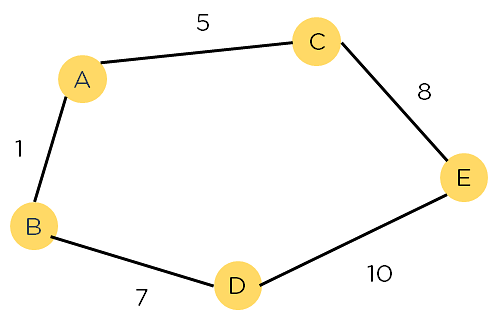
Determine 1: Weighted Graph
A significant downside of the set of rules is its area and time complexity. It takes a considerable amount of area to retailer all imaginable paths and a large number of time to search out them.
Programs of A* Set of rules
The A* set of rules is extensively utilized in more than a few domain names for pathfinding and optimization issues. It has packages in robotics, video video games, path making plans, logistics, and synthetic intelligence. In robotics, A* is helping robots navigate hindrances and in finding optimum paths. In video video games, it permits NPCs to navigate recreation environments intelligently. Direction making plans packages use A* to search out the shortest or quickest routes between places. Logistics industries make the most of A* for automobile routing and scheduling. A* may be hired in AI methods, comparable to herbal language processing and device finding out, to optimize decision-making processes. Its versatility and potency make it a treasured set of rules in lots of real-world eventualities.
Why A* Seek Set of rules?
A* Seek Set of rules is a straightforward and environment friendly seek set of rules that can be utilized to search out the optimum trail between two nodes in a graph. It is going to be used for the shortest trail discovering. It’s an extension of Dijkstra’s shortest trail set of rules (Dijkstra’s Set of rules). The extension here’s that, as a substitute of the usage of a concern queue to retailer the entire components, we use tons (binary bushes) to retailer them. The A* Seek Set of rules additionally makes use of a heuristic serve as that gives more information relating to how some distance clear of the objective node we’re. This serve as is used together with the f-heap knowledge construction in an effort to make looking out extra environment friendly.
Allow us to now have a look at a short lived rationalization of the A* set of rules.
Clarification
Within the match that we have got a grid with many hindrances and we need to get someplace as swiftly as imaginable, the A* Seek Algorithms are our savior. From a given beginning mobile, we will get to the objective mobile as briefly as imaginable. It’s the sum of 2 variables’ values that determines the node it choices at any time limit.
At every step, it choices the node with the smallest price of ‘f’ (the sum of ‘g’ and ‘h’) and processes that node/mobile. ‘g’ and ‘h’ is outlined as merely as imaginable beneath:
- ‘g’ is the space it takes to get to a undeniable sq. at the grid from the place to begin, following the trail we generated to get there.
- ‘h’ is the heuristic, which is the estimation of the space it takes to get to the end line from that sq. at the grid.
Heuristics are mainly skilled guesses. It will be significant to take into account that we have no idea the space to the end level till we discover the path since there are such a lot of issues that may get in the best way (e.g., partitions, water, and many others.). Within the coming sections, we will be able to dive deeper into methods to calculate the heuristics.
Allow us to now have a look at the detailed set of rules of A*.
Set of rules
Preliminary situation – we create two lists – Open Checklist and Closed Checklist.
Now, the next steps wish to be applied –
- The open listing will have to be initialized.
- Put the beginning node at the open listing (go away its f at 0). Initialize the closed listing.
- Observe the stairs till the open listing is non-empty:
- To find the node with the least f at the open listing and identify it “q”.
- Take away Q from the open listing.
- Produce q’s 8 descendants and set q as their father or mother.
- For each and every descendant:
i) If discovering a successor is the objective, stop having a look
ii)Else, calculate g and h for the successor.
successor.g = q.g + the calculated distance between the successor and the q.
successor.h = the calculated distance between the successor and the objective. We can quilt 3 heuristics to try this: the Diagonal, the Euclidean, and the New york heuristics.
successor.f = successor.g plus successor.h
iii) Skip this successor if a node within the OPEN listing with the similar location because it however a decrease f price than the successor is provide.
iv) Skip the successor if there’s a node within the CLOSED listing with the similar place because the successor however a decrease f price; in a different way, upload the node to the open listing finish (for loop).
- Push Q into the closed listing and finish the whilst loop.
We can now talk about methods to calculate the Heuristics for the nodes.
Heuristics
We will simply calculate g, however how can we calculate h?
There are two strategies that we will use to calculate the worth of h:
1. Resolve h’s actual price (which is indisputably time-consuming).
(or)
2. Make the most of more than a few ways to approximate the worth of h. (much less time-consuming).
Allow us to talk about each strategies.
Actual Heuristics
Even if we will download actual values of h, doing so most often takes a long time.
The techniques to decide h’s exact price are indexed beneath.
1. Earlier than the usage of the A* Seek Set of rules, pre-calculate the space between each and every pair of cells.
2. The use of the space components/Euclidean Distance, we would possibly without delay decide the correct price of h within the absence of blocked cells or obstructions.
Allow us to have a look at methods to calculate Approximation Heuristics.
Approximation Heuristics
To decide h, there are most often 3 approximation heuristics:
1. New york Distance
The New york Distance is the full of absolutely the values of the discrepancies between the x and y coordinates of the present and the objective cells.
The components is summarized beneath –
h = abs (curr_cell.x – objective.x) +
abs (curr_cell.y – objective.y)
We will have to use this heuristic manner after we are simplest authorized to transport in 4 instructions – best, left, proper, and backside.
Allow us to now check out the Diagonal Distance approach to calculate the heuristic.
2. Diagonal Distance
It’s not anything greater than the best absolute price of variations between the x and y coordinates of the present mobile and the objective mobile.
That is summarized beneath within the following components –
dx = abs(curr_cell.x – objective.x)
dy = abs(curr_cell.y – objective.y)
h = D * (dx + dy) + (D2 – 2 * D) * min(dx, dy)
the place D is the period of each and every node (default = 1) and D2 is the diagonal
We use this heuristic manner after we are authorized to transport simplest in 8 instructions, just like the King’s strikes in Chess.
Allow us to now check out the Euclidean Distance approach to calculate the heuristic.
3. Euclidean Distance
The Euclidean Distance is the space between the objective mobile and the present mobile the usage of the space components:
h = sqrt ( (curr_cell.x – objective.x)^2 +
(curr_cell.y – objective.y)^2 )
We use this heuristic manner after we are authorized to transport in any route of our selection.
The Elementary Thought of A* Set of rules
A heuristic set of rules sacrifices optimality, with precision and accuracy for pace, to unravel issues quicker and extra successfully.
All graphs have other nodes or issues which the set of rules has to take, to succeed in the overall node. The trails between those nodes all have a numerical price, which is regarded as as the load of the trail. The entire of all paths transverse will give you the price of that path.
To begin with, the Set of rules calculates the associated fee to all its fast neighboring nodes,n, and chooses the only incurring the least price. This procedure repeats till no new nodes can also be selected and all paths had been traversed. Then, you will have to believe the most efficient trail amongst them. If f(n) represents the overall price, then it may be denoted as :
f(n) = g(n) + h(n), the place :
g(n) = price of traversing from one node to every other. This may range from node to node
h(n) = heuristic approximation of the node’s price. This isn’t an actual price however an approximation price
How Does the A* Set of rules Paintings?
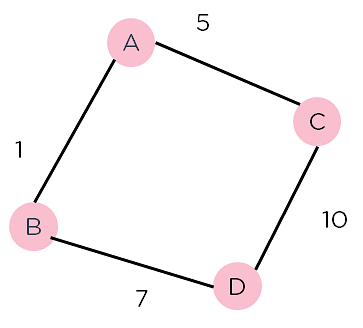
Determine 2: Weighted Graph 2
Believe the weighted graph above, which accommodates nodes and the space between them. Let’s consider you get started from A and feature to visit D.
Now, because the get started is on the supply A, which can have some preliminary heuristic price. Therefore, the effects are
f(A) = g(A) + h(A)
f(A) = 0 + 6 = 6
Subsequent, take the trail to different neighboring vertices :
f(A-B) = 1 + 4
f(A-C) = 5 + 2
Now take the trail to the vacation spot from those nodes, and calculate the weights :
f(A-B-D) = (1+ 7) + 0
f(A-C-D) = (5 + 10) + 0
It’s transparent that node B will give you the most efficient trail, so that’s the node you want to take to succeed in the vacation spot.
Pseudocode of A* Set of rules
The textual content beneath represents the pseudocode of the Set of rules. It may be used to put in force the set of rules in any programming language and is the fundamental good judgment in the back of the Set of rules.
- Make an open listing containing beginning node
- If it reaches the vacation spot node :
- Make a closed empty listing
- If it does no longer succeed in the vacation spot node, then believe a node with the bottom f-score within the open listing
We’re completed
Put the present node within the listing and take a look at its neighbors
- For every neighbor of the present node :
- If the neighbor has a decrease g price than the present node and is within the closed listing:
Change neighbor with this new node because the neighbor’s father or mother
- Else If (present g is decrease and neighbor is within the open listing):
Change the neighbor with the decrease g price and alter the neighbor’s father or mother to the present node.
- Else If the neighbor isn’t in each lists:
Upload it to the open listing and set its g
How you can Put in force the A* Set of rules
1. How you can Put in force the A* Set of rules in Python
Believe the graph proven beneath. The nodes are represented in crimson circles, and the weights of the trails alongside the nodes are given. The numbers above the nodes constitute the heuristic price of the nodes.
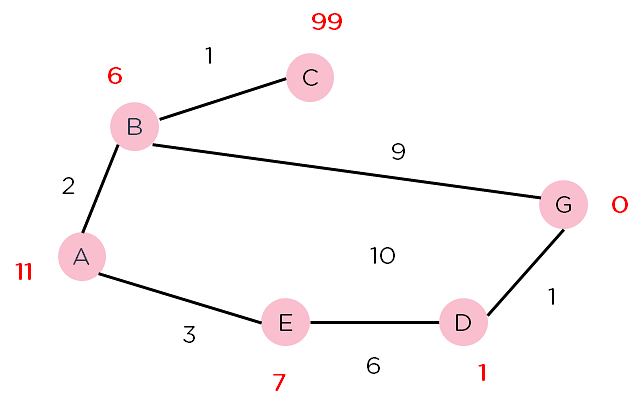
Determine 3: Weighted graph for A* Set of rules
You get started by means of growing a category for the set of rules. Now, describe the open and closed lists. Right here, you might be the usage of units and two dictionaries – one to retailer the space from the beginning node, and every other for father or mother nodes. And initialize them to 0, and the beginning node.
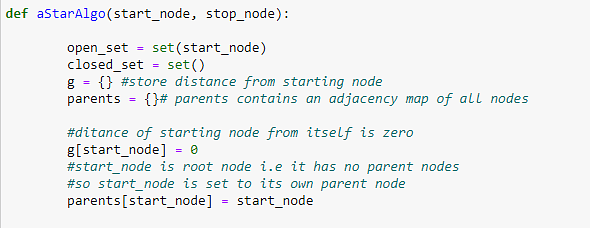
Determine 4: Initializing essential parameters
Now, in finding the neighboring node with the bottom f(n) price. You will have to additionally code for the situation of achieving the vacation spot node. If this isn’t the case, put the present node within the open listing if it isn’t already on it, and set its father or mother nodes.
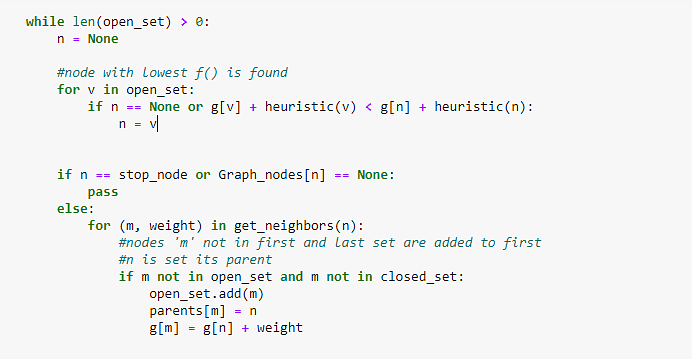
Determine 5: Including nodes to open listing and surroundings oldsters of nodes
If the neighbor has a decrease g price than the present node and is within the closed listing, change it with this new node because the neighbor’s father or mother.
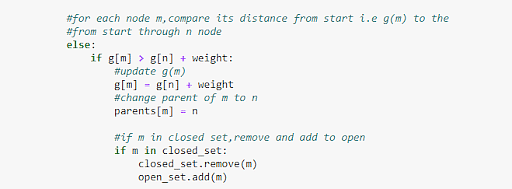
Determine 6: Checking distances and updating the g values
If the present g is less than the former g, and its neighbor is within the open listing, change it with the decrease g price and alter the neighbor’s father or mother to the present node.
If the neighbor isn’t in each lists, upload it to the open listing and set its g price.
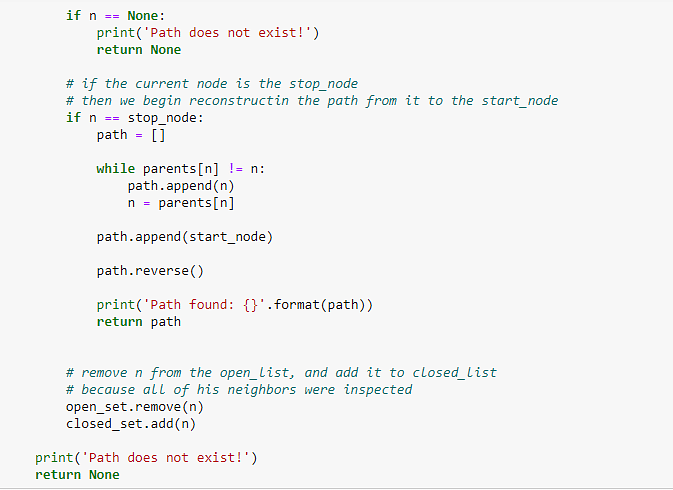
Determine 7: Checking distances, updating the g values, and including oldsters
Now, outline a serve as to go back neighbors and their distances.

Determine 8: Defining neighbors
Additionally, create a serve as to test the heuristic values.
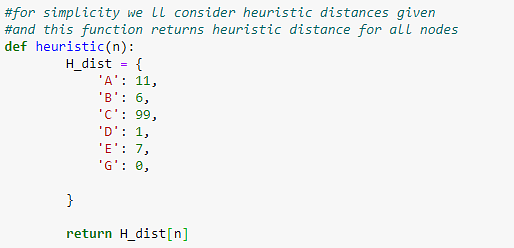
Determine 9: Defining a serve as to go back heuristic values
Let’s describe our graph and get in touch with the A celebrity serve as.
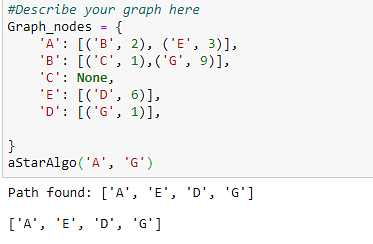
Determine 10: Calling A* serve as
The set of rules traverses during the graph and reveals the trail with the least price
which is thru E => D => G.
2. How you can Put in force the A* Set of rules in C++
#come with <iostream>
#come with <vector>
#come with <queue>
#come with <unordered_map>
#come with <cmath>
struct Node {
int x, y;
glide g, h;
Node* father or mother;
Node(int x, int y, glide g, glide h, Node* father or mother = nullptr)
: x(x), y(y), g(g), h(h), father or mother(father or mother) {}
glide f() const { go back g + h; }
bool operator<(const Node& different) const {
go back f() > different.f();
}
};
glide heuristic(int x1, int y1, int x2, int y2) {
go back std::sqrt((x2 - x1) * (x2 - x1) + (y2 - y1) * (y2 - y1));
}
std::vector<Node> get_neighbors(const Node& node, const std::vector<std::vector<int>>& grid) {
std::vector<Node> neighbors;
std::vector<std::pair<int, int>> instructions = {{1, 0}, {0, 1}, {-1, 0}, {0, -1}};
for (auto& dir : instructions) {
int newX = node.x + dir.first;
int newY = node.y + dir.2nd;
if (newX >= 0 && newX < grid.measurement() && newY >= 0 && newY < grid[0].measurement() && grid[newX][newY] == 0) {
neighbors.emplace_back(newX, newY, node.g + 1, 0, nullptr);
}
}
go back neighbors;
}
void reconstruct_path(Node* node) {
whilst (node) {
std::cout << "(" << node->x << "," << node->y << ") ";
node = node->father or mother;
}
std::cout << std::endl;
}
void astar(const std::vector<std::vector<int>>& grid, int startX, int startY, int goalX, int goalY) {
std::priority_queue<Node> openList;
std::unordered_map<int, std::unordered_map<int, Node*>> allNodes;
Node* startNode = new Node(startX, startY, 0, heuristic(startX, startY, goalX, goalY));
openList.push(*startNode);
allNodes[startX][startY] = startNode;
whilst (!openList.empty()) {
Node present = openList.best();
openList.pop();
if (present.x == goalX && present.y == goalY) {
reconstruct_path(&present);
go back;
}
auto neighbors = get_neighbors(present, grid);
for (auto& neighbor : neighbors) {
neighbor.h = heuristic(neighbor.x, neighbor.y, goalX, goalY);
neighbor.father or mother = allNodes[current.x][current.y];
if (!allNodes[neighbor.x][neighbor.y] || neighbor.g < allNodes[neighbor.x][neighbor.y]->g) {
allNodes[neighbor.x][neighbor.y] = new Node(neighbor);
openList.push(neighbor);
}
}
}
std::cout << "No trail discovered" << std::endl;
}
3. How you can Put in force the A* Set of rules in Java
import java.util.*;
magnificence Node implements Similar<Node> {
int x, y;
double g, h;
Node father or mother;
Node(int x, int y, double g, double h, Node father or mother) {
this.x = x;
this.y = y;
this.g = g;
this.h = h;
this.father or mother = father or mother;
}
double f() {
go back g + h;
}
@Override
public int compareTo(Node different) {
go back Double.evaluate(this.f(), different.f());
}
}
public magnificence AStar {
static double heuristic(int x1, int y1, int x2, int y2) {
go back Math.sqrt(Math.pow(x2 - x1, 2) + Math.pow(y2 - y1, 2));
}
static Checklist<Node> getNeighbors(Node node, int[][] grid) {
Checklist<Node> neighbors = new ArrayList<>();
int[][] instructions = {{1, 0}, {0, 1}, {-1, 0}, {0, -1}};
for (int[] dir : instructions) {
int newX = node.x + dir[0];
int newY = node.y + dir[1];
if (newX >= 0 && newX < grid.period && newY >= 0 && newY < grid[0].period && grid[newX][newY] == 0) {
neighbors.upload(new Node(newX, newY, node.g + 1, 0, null));
}
}
go back neighbors;
}
static void reconstructPath(Node node) {
whilst (node != null) {
Machine.out.print("(" + node.x + "," + node.y + ") ");
node = node.father or mother;
}
Machine.out.println();
}
static void astar(int[][] grid, int startX, int startY, int goalX, int goalY) {
PriorityQueue<Node> openList = new PriorityQueue<>();
Map<String, Node> allNodes = new HashMap<>();
Node startNode = new Node(startX, startY, 0, heuristic(startX, startY, goalX, goalY), null);
openList.upload(startNode);
allNodes.put(startX + "," + startY, startNode);
whilst (!openList.isEmpty()) {
Node present = openList.ballot();
if (present.x == goalX && present.y == goalY) {
reconstructPath(present);
go back;
}
for (Node neighbor : getNeighbors(present, grid)) {
neighbor.h = heuristic(neighbor.x, neighbor.y, goalX, goalY);
neighbor.father or mother = present;
String key = neighbor.x + "," + neighbor.y;
if (!allNodes.containsKey(key) || neighbor.g < allNodes.get(key).g) {
allNodes.put(key, neighbor);
openList.upload(neighbor);
}
}
}
Machine.out.println("No trail discovered");
}
}
4. How you can Put in force the A* Set of rules in C#
the usage of Machine;
the usage of Machine.Collections.Generic;
magnificence Node : IComparable<Node> {
public int x, y;
public glide g, h;
public Node father or mother;
public Node(int x, int y, glide g, glide h, Node father or mother = null) {
this.x = x;
this.y = y;
this.g = g;
this.h = h;
this.father or mother = father or mother;
}
public glide F() {
go back g + h;
}
public int CompareTo(Node different) {
go back F().CompareTo(different.F());
}
}
magnificence AStar {
static glide Heuristic(int x1, int y1, int x2, int y2) {
go back (glide)Math.Sqrt(Math.Pow(x2 - x1, 2) + Math.Pow(y2 - y1, 2));
}
static Checklist<Node> GetNeighbors(Node node, int[,] grid) {
Checklist<Node> neighbors = new Checklist<Node>();
int[,] instructions = { { 1, 0 }, { 0, 1 }, { -1, 0 }, { 0, -1 } };
for (int i = 0; i < instructions.GetLength(0); i++) {
int newX = node.x + instructions[i, 0];
int newY = node.y + instructions[i, 1];
if (newX >= 0 && newX < grid.GetLength(0) && newY >= 0 && newY < grid.GetLength(1) && grid[newX, newY] == 0) {
neighbors.Upload(new Node(newX, newY, node.g + 1, 0, null));
}
}
go back neighbors;
}
static void ReconstructPath(Node node) {
whilst (node != null) {
Console.Write($"({node.x},{node.y}) ");
node = node.father or mother;
}
Console.WriteLine();
}
public static void AStarSearch(int[,] grid, int startX, int startY, int goalX, int goalY) {
PriorityQueue<Node> openList = new PriorityQueue<Node>();
Dictionary<string, Node> allNodes = new Dictionary<string, Node>();
Node startNode = new Node(startX, startY, 0, Heuristic(startX, startY, goalX, goalY));
openList.Enqueue(startNode);
allNodes.Upload($"{startX},{startY}", startNode);
whilst (openList.Rely > 0) {
Node present = openList.Dequeue();
if (present.x == goalX && present.y == goalY) {
ReconstructPath(present);
go back;
}
foreach (Node neighbor in GetNeighbors(present, grid)) {
neighbor.h = Heuristic(neighbor.x, neighbor.y, goalX, goalY);
neighbor.father or mother = present;
string key = $"{neighbor.x},{neighbor.y}";
if (!allNodes.ContainsKey(key) || neighbor.g < allNodes[key].g) {
allNodes[key] = neighbor;
openList.Enqueue(neighbor);
}
}
}
Console.WriteLine("No trail discovered");
}
}
5. How you can Put in force the A* Set of rules in JavaScript
magnificence Node {
constructor(x, y, g, h, father or mother = null) {
this.x = x;
this.y = y;
this.g = g;
this.h = h;
this.father or mother = father or mother;
}
f() {
go back this.g + this.h;
}
}
serve as heuristic(x1, y1, x2, y2) {
go back Math.sqrt(Math.pow(x2 - x1, 2) + Math.pow(y2 - y1, 2));
}
serve as getNeighbors(node, grid) {
const neighbors = [];
const instructions = [[1, 0], [0, 1], [-1, 0], [0, -1]];
for (const [dx, dy] of instructions) {
const newX = node.x + dx;
const newY = node.y + dy;
if (newX >= 0 && newX < grid.period && newY >= 0 && newY < grid[0].period && grid[newX][newY] === 0) {
neighbors.push(new Node(newX, newY, node.g + 1, 0, null));
}
}
go back neighbors;
}
serve as reconstructPath(node) {
whilst (node) {
console.log(`(${node.x},${node.y})`);
node = node.father or mother;
}
}
serve as astar(grid, startX, startY, goalX, goalY) {
const openList = [];
const allNodes = new Map();
const startNode = new Node(startX, startY, 0, heuristic(startX, startY, goalX, goalY));
openList.push(startNode);
allNodes.set(`${startX},${startY}`, startNode);
whilst (openList.period > 0) {
openList.kind((a, b) => a.f() - b.f());
const present = openList.shift();
if (present.x === goalX && present.y === goalY) {
reconstructPath(present);
go back;
}
const neighbors = getNeighbors(present, grid);
for (const neighbor of neighbors) {
neighbor.h = heuristic(neighbor.x, neighbor.y, goalX, goalY);
neighbor.father or mother = present;
const key = `${neighbor.x},${neighbor.y}`;
if (!allNodes.has(key) || neighbor.g < allNodes.get(key).g) {
allNodes.set(key, neighbor);
openList.push(neighbor);
}
}
}
console.log("No trail discovered");
}
Those implementations are elementary and think a grid-based map the place 0 represents a walkable mobile, and another price represents a disadvantage. The A* set of rules makes use of a concern queue (or identical construction) to discover nodes with the bottom price first. The heuristic used is the Euclidean distance, however different heuristics like New york distance will also be carried out relying at the downside.
Be sure you regulate those implementations to suit the particular wishes of your utility, comparable to including extra refined dealing with of hindrances, imposing a greater precedence queue, or bettering the trail reconstruction.
Benefits of A* Set of rules in AI
The A* set of rules provides a number of benefits.
- At the beginning, it promises discovering the optimum trail when used with suitable heuristics.
- Secondly, it’s environment friendly and will care for huge seek areas by means of successfully pruning unpromising paths.
- Thirdly, it may be simply adapted to house other downside domain names and heuristics.
- Fourthly, A* is versatile and adaptable to various terrain prices or constraints. Moreover, it’s extensively applied and has a limiteless quantity of assets and strengthen to be had.
General, the benefits of A* set of rules in AI make it a well-liked selection for fixing pathfinding and optimization issues.
Disadvantages of A* Set of rules in AI
Whilst the A* set of rules in AI has a large number of benefits, it additionally has some barriers.
- One drawback is that A* can also be computationally dear in positive eventualities, particularly when the hunt area is in depth and the choice of imaginable paths is big.
- The set of rules would possibly eat important reminiscence and processing assets.
- Every other limitation is that A* closely depends on the standard of the heuristic serve as. If the heuristic is poorly designed or does no longer as it should be estimate the space to the objective, the set of rules’s efficiency and optimality could also be compromised.
- Moreover, A* would possibly combat with positive sorts of graphs or seek areas that showcase abnormal or unpredictable constructions.
What if the hunt area in A* Set of rules isn’t a grid and is a graph?
The A* set of rules can also be carried out to non-grid seek areas which are represented as graphs. On this case, the nodes within the graph constitute states or places, and the perimeters constitute the connections or transitions between them. The important thing distinction lies within the definition of neighbors for every node, which is decided by means of the perimeters within the graph reasonably than the adjoining cells in a grid. A* set of rules can nonetheless be used to search out the optimum trail in such graph-based seek areas by means of correctly defining the heuristic serve as and imposing the important knowledge constructions and algorithms to traverse the graph.
A* Set of rules Instance
A* has been effectively carried out in a large number of real-world eventualities. For example, in robot trail making plans, A* is helping robots navigate thru dynamic environments whilst warding off hindrances. In recreation building, A* is used to create clever enemy AI that may chase and apply the participant successfully. In logistics and transportation, A* assists find the optimum routes for supply cars, minimizing time and price. Moreover, A* set of rules has packages in community routing, comparable to discovering the shortest trail in a pc community. Those examples spotlight the flexibility and practicality of A* set of rules ideas and implementations in more than a few domain names.
Grasp the A* Set of rules in AI
On this educational, an advent to the tough seek set of rules’, you realized about the entirety concerning the set of rules and noticed the fundamental thought in the back of it. Then you definitely appeared into the operating of the set of rules, and the pseudocode for A*.
Simplilearn’s Synthetic Intelligence Engineer Grasp Program is designed to lend a hand beginners decode the thriller of man-made intelligence and its trade packages. The direction is helping you grasp the AI ideas and workflows, device finding out and deep finding out, NLP, generati9ve AI and extra. Discover and join as of late!
Select the Proper Program
Supercharge your occupation in AI and ML with Simplilearn’s complete classes. Acquire the abilities and data to develop into industries and unharness your true doable. Join now and release countless probabilities!
Program Identify AI Engineer Put up Graduate Program In Synthetic Intelligence Put up Graduate Program In Synthetic Intelligence Geo All Geos All Geos IN/ROW College Simplilearn Purdue Caltech Direction Period 11 Months 11 Months 11 Months Coding Enjoy Required Elementary Elementary No Abilities You Will Be informed 10+ abilities together with knowledge construction, knowledge manipulation, NumPy, Scikit-Be informed, Tableau and extra. 16+ abilities together with
chatbots, NLP, Python, Keras and extra.8+ abilities together with
Supervised & Unsupervised Studying
Deep Studying
Information Visualization, and extra.Further Advantages Get get right of entry to to unique Hackathons, Masterclasses and Ask-Me-Anything else periods by means of IBM
Implemented finding out by means of 3 Capstone and 12 Trade-relevant TasksPurdue Alumni Affiliation Club Loose IIMJobs Professional-Club of 6 months Resume Construction Help Upto 14 CEU Credit Caltech CTME Circle Club Price $$ $$$$ $$$$ Discover Program Discover Program Discover Program
FAQs
1. Why is it known as the A* set of rules in AI?
The A* set of rules will get its identify from two key options. The “A” stands for “Admissible” because it makes use of an admissible heuristic to estimate prices. The “*” means that it combines exact and estimated prices to make knowledgeable selections all through the hunt procedure.
2. What are the homes of A* set of rules in AI?
The A* set of rules possesses homes of completeness, optimality, and potency. It promises discovering an answer if one exists (completeness), reveals the optimum trail with the bottom price (optimality), and successfully explores fewer nodes through the use of heuristics (potency).
3. What are the principle parts of A* set of rules in AI?
The principle parts of the A* set of rules come with an open listing to trace nodes to discover, a closed listing to retailer evaluated nodes, a heuristic serve as to estimate prices, a value serve as to assign prices to movements, and a concern queue to decide the order of node enlargement in accordance with estimated prices.
supply: www.simplilearn.com








